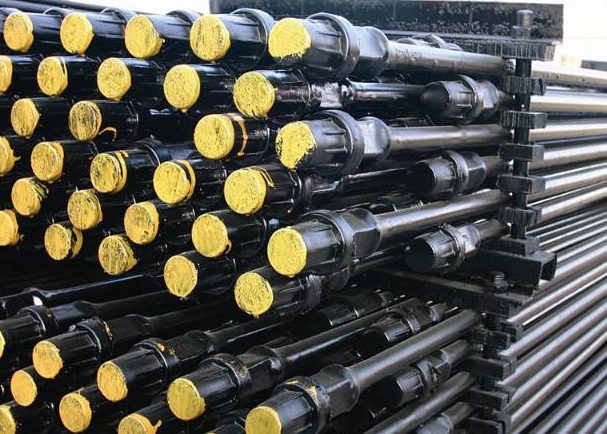API 11B Steel Sucker Rod: The API 11B Steel Sucker Rod is a slender, elongated bar utilized in pumping wells. It conforms to the specifications outlined in API SPEC 11B, which covers sucker rods, polished rods, liners, couplings, sinker bars, polished rod clamps, stuffing boxes, and pumping tees. The sucker rod connects to a polished bar above and operates the pump at the well's bottom, serving the purpose of power transmission.
Typically, steel sucker rods are 7.6 or 8 meters in length and are crafted from high-carbon steel. They are surface-plated with hard chrome. These rods are interconnected within the tubing, one after another, until reaching the oil layer where they facilitate the pumping of oil through vertical up-and-down movements.

Scope of Steel Sucker Rods: The API 11B standard for sucker rods delineates specifications encompassing size, mechanical attributes, inspection procedures, and testing methods. It encompasses various products such as general sucker rods, fiber-reinforced plastic sucker rods, couplings, reducing couplings, polished couplings, polished bars, and sinker bars.
Classification of Steel Sucker Rods:
- Ordinary Sucker Rods:Grade C, D, K, and KD sucker rods.
- High-Strength Sucker Rods:Grade H sucker rods, including HY, HL, and KHL types.
- Special Sucker Rods:Hollow sucker rods and steel rods.
- Consecutive Sucker Rods:Steel rods.
- Sucker Rods for Screw Pump Use:Taper thread and plugging-type sucker rods.
- Fiberglass Reinforced Plastic (FRP) Sucker Rods:Fiber plastic sucker rods.
- Flexible Sucker Rods:Carbon fiber compatible material and wire rope sucker rods.
- Other Sucker Rods:Electric sucker rods.
Grades and Types:
- Grade C:Utilized in light-to-medium load and non-corrosive or anti-corrosive oil wells. Manufactured from AISI 1530 Mod steel.
- Grade K:Used in corrosive light-to-medium load oil wells. Manufactured from AISI 4621 Mod steel.
- Carbon Steel Grade D:Employed in non-corrosive or anti-corrosive medium-to-heavy load oil wells. Manufactured from AISI 1530 Mod low-alloy steel.
- Alloy Steel Grade D:Used in non-corrosive or anti-corrosive medium-to-heavy load oil wells. Manufactured from AISI 4142 Mod steel.
- Grade KD Sucker Rod:Combines anti-corrosion properties of grade K with mechanical properties of grade D. Manufactured from AISI 4320 Mod steel.
- Grade D Special Sucker Rod:Employed in medium-to-heavy anti-corrosive oil wells. Manufactured from 4330 Mod steel.
- Grade H Sucker Rod:
- Used in heavy-to-overweight load oil wells.
- Type HL Sucker Rod: Achieves grade H through appropriate material selection and processing.
- Type HY Sucker Rod: Mechanical properties reach grade H through quenching process.
Grade and Mechanical Properties of the sucker rod
| No. | Grade | Tensile Strength Rel (Mpa) | Yield Strength Rm (Mpa) | Percentage Elongation A(%) | Contraction Percentage Of Area Z (%) |
| 1 | C | 620-795 | ≥415 | ≥13 | ≥50 |
| 2 | K | 620-795 | ≥415 | ≥13 | ≥60 |
| 3 | D | 795-965 | ≥590 | ≥10 | ≥50 |
| 4 | KD | 795-965 | ≥590 | ≥10 | ≥50 |
| 5 | HL | 965-1195 | ≥795 | ≥10 | ≥45 |
| 6 | HY | 965-1195 | —— | —— | —— |
Pony rods are a type of sucker rod, but shorter in length compared to standard sucker rods. They are utilized to assemble a sucker rod string of the desired length, connecting a piston pump to the surface of an oil well. These rods are threaded on both ends and typically come in diameters of 3/4 inch, 7/8 inch, and 1 inch. Due to their high tensile strength, pony rods are suitable for various conditions, including high loads and corrosive environments, allowing for better control over rod friction. Manufactured in AISI 1530 Mod, pony rods offer excellent performance, even in deep oil wells.
Pony rods play a crucial role in artificial lift systems, thus requiring specific heat treatments to enhance performance and durability. Generally, pony rods are classified into three main grades: Grade C, K, and D, differentiated by their tensile strength. For example, Grade C has a maximum tensile strength of up to 115,000 psi, while Grade K can reach a maximum tensile strength of 140,000 psi. Positioned beneath the polished rod of the rod string, pony rods prevent the string from falling down. Moreover, it's essential to avoid using old rods for load-bearing parts to prevent potential errors.








